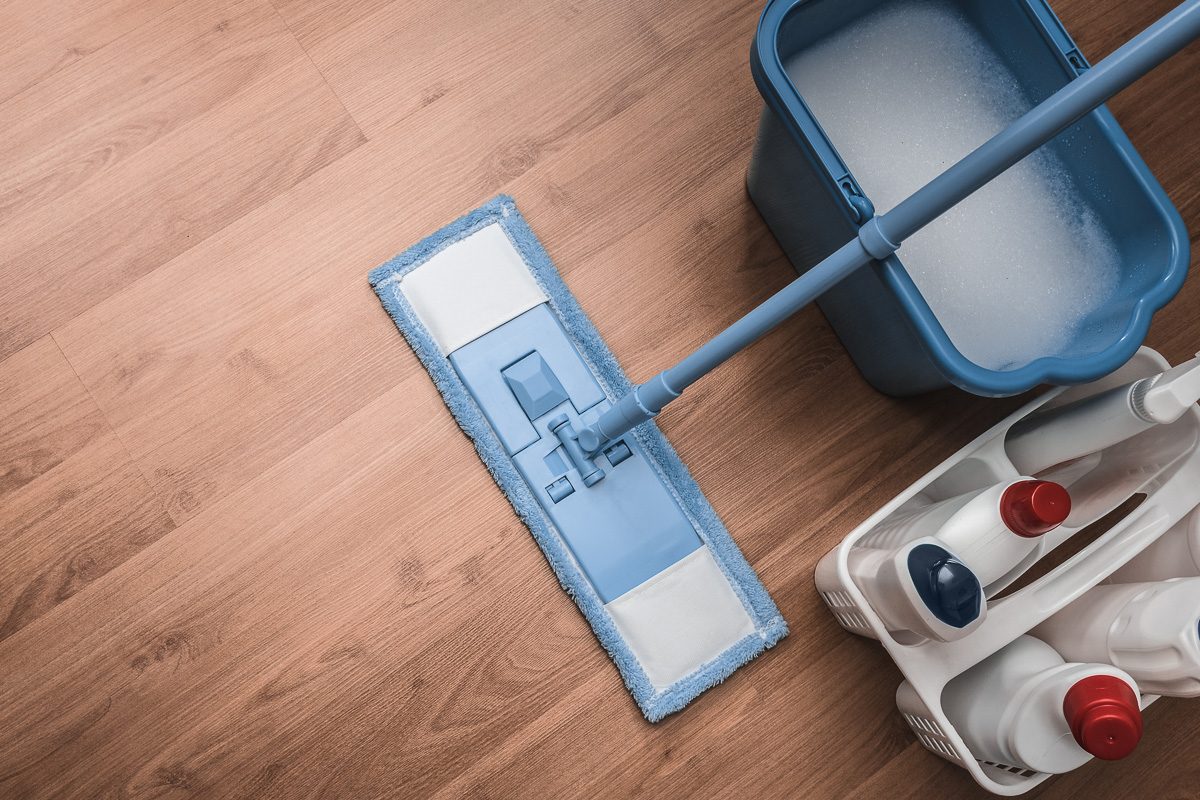These pro tips will help ditch grime and boost shine without causing scratches or stains when you clean vinyl plank flooring.
Introduction
In my previous life, before returning to journalism, I owned a bustling specialist dog shop. We installed luxury vinyl plank flooring because it's durable, stands up well to enthusiastic claws, and is easy to clean when there are those inevitable puppy potty puddles. When I sold the business after ten years, the flooring was still going strong. Learning how to properly clean vinyl plank flooring contributed to the surface's longevity.
I spoke with two experts to get their cleaning tips for keeping your flooring sparkling without risking discoloration or scratches.
Tools Required
- Dustpan
- Microfiber broom mop
- Mop bucket or laundry sink or bathtub
- O-Cedar spin wet mop
- Swing buffer
- vacuum cleaner
Materials Required
- White vinegar or pH-neutral floor cleaner
Project step-by-step (5)
Sweep or Vacuum Flooring
Always sweep and/or vacuum before mopping your vinyl plank flooring. You want to lift dirt and debris. Otherwise, gritty particles can have a sandpaper effect on the floor surface, leading to damage over time. This can make your floor more susceptible to stains, moisture damage and discoloration.
Jenne Ross, Director of Product for luxury vinyl flooring Karndean, recommends using a dry microfiber broom mop. If you’re using a vacuum, select the bare floor setting to prevent the beater bar from damaging the surface.

Prepare the Cleaning Solution
Where possible, follow the flooring manufacturer’s instructions for cleaning vinyl plank flooring and select a cleaning product they recommend. For example, Ross says they only recommend two cleaning solutions for Karndean — “Karndean Clean or white [cleaning] vinegar with warm water, max ¼ cup to 1 gallon of water.”
Ron Baker, Senior Technical Manager at Gerflor USA, recommends using commercial-grade pH-neutral cleaners on their flooring. “It’s important the pH levels are within 7 – 11,” he says. “Anything below 7 is acidic and is not good for resilient floorings, and anything above 11 is too alkaline and could also damage floorings over time.”

Test the Cleaning Solution
When you clean vinyl plank flooring, always test the solution on an inconspicuous section first to ensure it doesn’t cause discoloration. Allow the solution to dry fully before deciding if it’s suitable.

Mop Flooring
Select a microfiber mop or, as per Ross’ recommendation, an O-Cedar spin wet mop. “We advise against products like Swiffer spray mop and Swiffer wet pads,” Ross says. These products can leave a sticky residue on the floor, and they aren’t the most green cleaning options.
Always wring out the mop head properly. It should be damp but not dripping. If it’s overly wet, this can apply too much moisture to the floor, increasing the risk of water damage.
“When mopping, keep mop water clean – change it out while mopping if necessary,” Ross recommends. This prevents a buildup of gritty particles or dirty smears from being spread around the floor.
While you don’t want to leave excess moisture on your vinyl plank flooring too long, letting the cleaner sit for a couple of minutes before mopping can be beneficial when there is a layer of ingrained dirt. “Many times, the cleaner needs sufficient ‘dwell’ time to soften the dirt,” Baker says.

Remove Stubborn Scuffs
Ross explains that Mr. Clean Magic Eraser can be effective at removing stubborn scuffs or stains. However, Baker cautions that this can damage the surface of some vinyl plank flooring. Always test the product on an inconspicuous part of the floor first.
Baker recommends using an autoscrubber or swing buffer for a 3M Red pad to deep clean the flooring occasionally. “In some cases, a 3M 5300 Blue pad may be needed if there is a significant amount of dirt build up,” he says. “For tight areas where an autoscrubber cannot reach, a doodlebug handheld scrubber with a 3M Red pad can be used.” He explains that you should never use a pad more aggressive than a 3M 5300 pad, as they can abrade the factory-applied surface coating.

FAQ
Are there any cleaning materials you can’t use on vinyl plank flooring?
Avoid using abrasive or bleach-based cleaners, as they can damage vinyl plank flooring. Floor polishes and waxes can make your floor slippery and also compromise the surface seal.
How do you prevent vinyl floors from getting dirty?
“Vinyl-backed walk-off mats are very important to trap dirt and prevent it from reaching the flooring,” Baker says. “Rubber products such as furniture protectors, tires, or rubber-backed floor mats can leave permanent yellowish stains on all manufacturer’s vinyl flooring products.”
About the Experts
- Ron Baker, Senior Technical Manager at Gerflor USA. The company creates and manufactures innovative, decorative and eco-responsible solutions for flooring and interior finishes; email interview, 23. June, 2025.
- Jenne Ross, Director of Product at Karndean. The company specializes in manufacturing luxury vinyl flooring (LVT); email interview, 26. June, 2025.




















